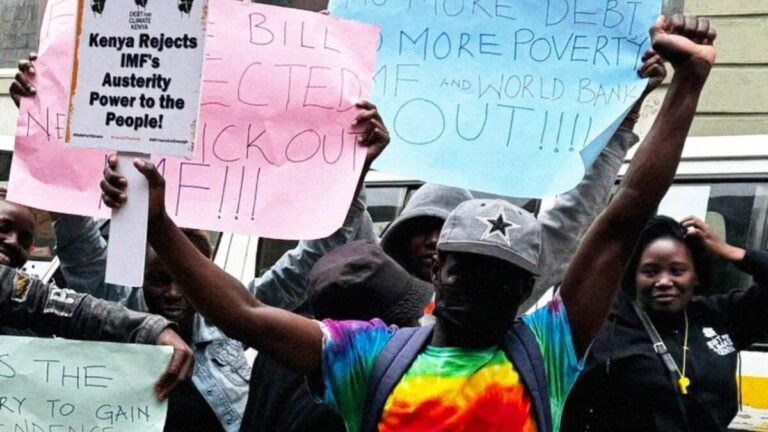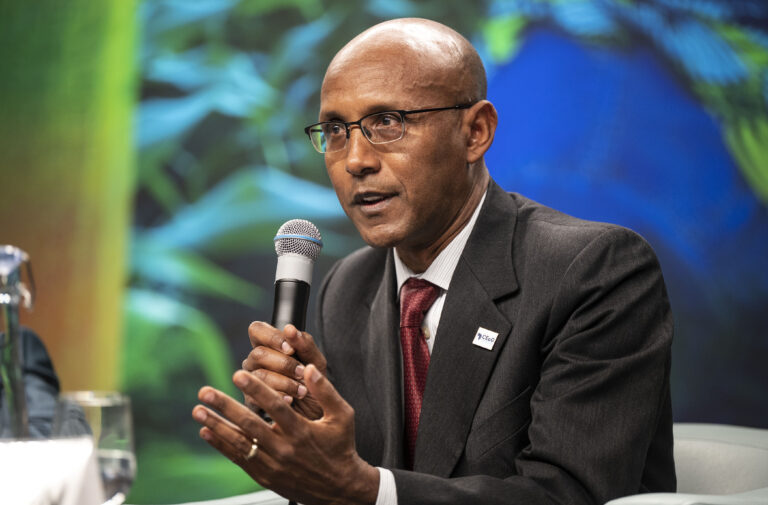
Children walk barefoot to school in Marsabit County, braving long distances and scorching heat to attend lessons held under trees. (Photo/Xinhua).
By Daisy Okiring
“We sit on stones and write on our laps. Sometimes, we don’t even have books. But we still come. Because we want to be teachers, doctors, pilots.” — Fatuma, 12, student, Marsabit County, Kenya.
At dawn in the sun-baked village of Kargi in northern Kenya, barefoot children make their way to school—some walking over 10 kilometers. Their destination: a crumbling classroom with no electricity, no desks, and often, no chalk. Yet they arrive, determined to learn.
This is the untold story of thousands of children in Kenya’s arid and semi-arid lands (ASALs) whose dreams persist against the odds. While the right to free and compulsory basic education is enshrined in Kenya’s Constitution (Article 53), for many children in these remote regions, education remains a daily battle.
A National Crisis in the Shadows
According to Kenya’s Ministry of Education, over 1.2 million children in the country are out of school—more than 60 percent of them in ASALs, including counties like Turkana, Mandera, Wajir, and Marsabit. These regions have long been neglected due to insecurity, poverty, and harsh climate conditions.
In Turkana County, one of Kenya’s poorest, the pupil-to-classroom ratio stands at over 90:1, compared to the national average of 45:1. Many classes are held under trees, with lessons paused during rains or extreme heat. A 2022 UNESCO report noted that only 35 percent of children in ASAL counties complete primary education. Girls are particularly vulnerable—early marriages, female genital mutilation (FGM), and domestic responsibilities push many out of school before puberty.
“The situation is dire. These children are being left behind in every sense,” says Dr. Julius Jwan, former Principal Secretary for Basic Education in Kenya.
Read More: The forgotten communities of Remba Island
No Chalk, No Books, No Teachers
A visit to schools in Isiolo or West Pokot reveals just how deep the disparities run. In one classroom meant for 40, over 100 pupils squeeze in, sharing torn textbooks—sometimes five to a book. Chalk is a luxury, and when it runs out, teachers resort to sticks and sand for writing demonstrations.
The crisis is worsened by an acute teacher shortage. The Teachers Service Commission (TSC) estimates a national shortfall of over 114,000 teachers, with ASAL counties most affected. Most teachers are reluctant to work in insecure and underserved areas, leading to chronic understaffing and burnout.
“We feel abandoned. Even when we try, we don’t have the resources,” says Esther Lokwang, a headteacher in Turkana. “We’ve written letters to the ministry, to the county, but we rarely get help.”

Fighting the Odds: Stories of Resilience
Despite the grim statistics, the human spirit in these regions remains unbreakable. Twelve-year-old Fatuma wakes up at 5:30 a.m. each day to help her mother fetch water before heading to school. She dreams of becoming a doctor, inspired by the one medic in their dispensary who saved her brother’s life.
In Garissa, an informal girls’ boarding school run by Womankind Kenya, an NGO that champions women’s rights, offers a safe haven for girls escaping early marriage. They receive not just shelter, but uniforms, sanitary pads, and counseling—small yet transformative interventions.
Read More: How Kenyan girls are lured into Russian war
“Education is more than books; it’s a shield against poverty, abuse, and hopelessness,” said the late Dr. Joyce Laboso, former Bomet Governor, in a 2018 keynote address. Her legacy continues to inspire girls from marginalized communities.

Who Is Stepping In?
Several organizations have stepped in to bridge the education gap in arid Kenya. UNICEF runs mobile school units and “education in emergencies” programs to reach children displaced by drought. Windle International Kenya has extended education access to refugees and host communities in Kakuma and Dadaab, while the Shule Yangu Alliance continues to protect public school land from encroachment and misuse.
The World Bank, through the Global Partnership for Education (GPE), has also invested in infrastructure and teacher training for underserved areas. However, a 2023 GPE report revealed that while Kenya allocates about 5.3 percent of its GDP to education, less than one percent of that budget directly targets ASAL-specific projects—highlighting a troubling resource gap.

Technology as a Lifeline
Some innovative solutions are offering hope. In Marsabit, BRCK Education has deployed “Kio Kits”—solar-powered digital learning kits loaded with curriculum content, allowing education to continue even in the absence of trained teachers. In Samburu, a partnership between the Safaricom Foundation and Zizi Afrique is running remedial literacy and numeracy camps, helping out-of-school children catch up with their peers.

Still, infrastructure and connectivity challenges persist. Only 17 percent of schools in Kenya’s ASAL counties have reliable internet, limiting the scalability of digital learning platforms.
Read More: County seeks share of Lake Nakuru National Park tourism revenue
The Way Forward
Education experts argue that solving the crisis will require targeted interventions across multiple levels. One key step is improving teacher incentives—through hardship allowances, better housing, and career growth opportunities—to attract and retain qualified staff in remote counties.
Gender-sensitive policies are also essential. These include constructing girls-only dormitories, hiring female teachers as mentors, and intensifying public awareness campaigns to challenge cultural practices like child marriage and FGM that hinder girls’ education.
Equally important is the need to invest in physical infrastructure—building permanent classrooms, sanitation blocks, and school-based water sources that allow children to stay in school even during extreme weather. Involving local leaders in school management, budgeting, and advocacy can also help ensure community ownership and accountability.
“We need to stop treating these children as afterthoughts,” says Dr. Sara Ruto, former Chief Administrative Secretary in the Ministry of Education. “They are Kenya’s future—and they’re slipping away.”
Fatuma, like many children across the dry north of Kenya, doesn’t ask for much—just a desk, a teacher, and a fair shot. Her dusty classroom without chalk might be invisible to most of the country, but within its walls lies fierce determination and hope.
The stories from Turkana, Marsabit, and Garissa are not just about poverty—they are about possibility. These children deserve more than policy papers and promises. They deserve classrooms with chalk—and futures with dignity.




7 thoughts on “Kenya Forgotten Schools: Education in arid regions”
Comments are closed.